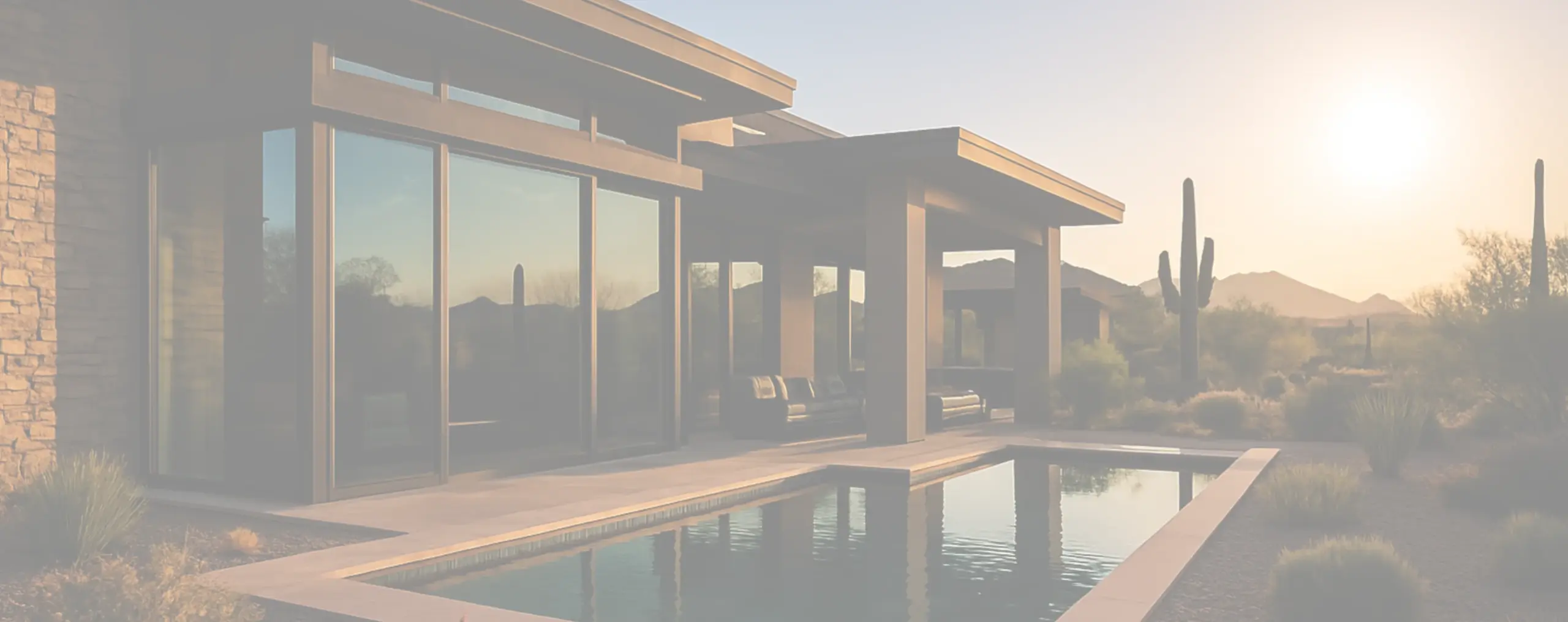In Phoenix and Tucson, homeowners live with a reality that people in other parts of the country only experience for a week or two each year: months of triple-digit temperatures, intense afternoon sun, and air conditioners that seem to run nonstop from late spring through early fall. Even well-insulated homes can feel like they are fighting against the desert climate, especially when large windows, patio sliders, and transoms allow heat and glare to pour inside. As electric rates climb and more people work from home, residents are looking for practical upgrades that can lower cooling costs without giving up natural light, views, or curb appeal. That is exactly why energy-saving window tint has moved from a “nice-to-have” to a smart, strategic home improvement across the Valley and the Old Pueblo.
Unlike heavy blackout curtains or exterior shade screens that can dramatically change the appearance of a home, modern architectural window films are designed to work quietly in the background. High-quality films can reject a significant portion of solar heat while still allowing visible light to pass through, which means rooms stay brighter and more comfortable without relying on the A/C as heavily. For Phoenix and Tucson homeowners who are tired of choosing between blazing sunshine and a dark, cave-like interior, energy-saving window tint offers a balanced solution that respects both comfort and aesthetics. It is not just about surviving summer anymore; it is about creating a home that performs better year-round.
How Desert Heat Impacts Windows and Energy Bills
To understand why window tint has become such a popular upgrade, it helps to look at how much work windows are forcing your cooling system to do in a desert climate. Standard clear glass allows a large percentage of solar energy to pass through, and when that sunlight hits your floors, furniture, and walls, it turns into heat. In Phoenix and Tucson, west- and south-facing windows are especially problematic because they take the brunt of the afternoon sun when temperatures are already at their peak. The result is classic hot spots: rooms that feel five to ten degrees warmer than the rest of the house, even when the thermostat says everything should be comfortable. Your air conditioner has no choice but to keep cycling to try and balance out those temperature differences.
Over time, that added load translates into higher utility bills and more wear and tear on expensive HVAC equipment. Homeowners may try DIY fixes like reflective stick-on panels or thick drapes, but those often sacrifice natural light or fall short in terms of performance and longevity. The challenge is that in Arizona’s climate, the issue is not just brightness; it is the infrared portion of sunlight that carries heat into the home. Energy-saving window films are engineered to address that specific problem by selectively blocking a large portion of heat-producing wavelengths while still letting in enough visible light to keep rooms feeling open and inviting. This targeted approach to solar control is a key reason why so many homeowners are reconsidering how their glass affects comfort and energy use.
How Energy-Saving Window Tint Works
Energy-saving window tints use advanced coatings and materials to manage how sunlight interacts with your glass. Many films contain microscopic metal, ceramic, or multi-layered components that reflect or absorb solar energy before it can pass into the living space. When properly installed, these films can significantly reduce solar heat gain, cut glare, and block a high percentage of UV rays that fade furniture, flooring, and artwork. Importantly, this performance does not require a dark, mirrored look. Modern films designed for homes in places like Phoenix and Tucson can be surprisingly neutral in appearance, allowing homeowners to maintain a clean, natural aesthetic from both inside and outside the property.
If you want to dive deeper into the broader efficiency picture, the U.S. Department of Energy notes that choosing the right energy-efficient window coverings can play an important role in reducing solar heat gain and improving overall comfort. In hot, sunny regions, that guidance aligns closely with the benefits that quality window films offer. By working with a professional installer who understands local conditions, homeowners can match film performance to their specific needs—whether that is maximizing heat rejection on a large glass wall, reducing glare in a home office, or protecting sun-exposed areas like living rooms and dining spaces.
Why Phoenix and Tucson Homeowners Are Making the Switch
In both Phoenix and Tucson, there has been a noticeable shift in how homeowners think about energy use inside their houses. Rising electric rates, longer cooling seasons, and increased remote work mean that comfort is not just an evening or weekend concern anymore; people are spending much more time at home throughout the day. Rooms that were tolerable in the past may now feel unusable during summer afternoons, especially if they have large windows overlooking patios, pools, or views of the mountains. By investing in professional residential window tinting, homeowners can rein in those problem areas and reclaim spaces that once felt like heat traps.
Another reason for the growing interest in window film is that it offers multiple benefits in a single upgrade. Yes, reducing heat is the headline feature, but homeowners also appreciate the way tint cuts harsh glare off tile floors, countertops, and TV screens. In Phoenix and Tucson, evening sun can make it difficult to relax in a living room or watch a game without squinting, even when the thermostat is set low. With the right film in place, those same spaces become more visually comfortable, and the house feels more evenly cooled. Over time, the added protection against UV damage also helps preserve finishes, furniture, and flooring, which can be a meaningful cost savings for homeowners with newer interiors or high-end materials.
Choosing the Right Film for Arizona Homes
Selecting the right window film is not a one-size-fits-all decision, particularly in Arizona where neighborhoods, home designs, and exposures vary widely. A stucco home in north Phoenix with large west-facing windows may need a more aggressive solar control film to keep a great room comfortable, while a brick bungalow in central Tucson with mature shade trees might benefit more from a lighter film that focuses on UV rejection and modest heat reduction. Factors such as existing glass type, HOA requirements, and personal preference for how reflective or neutral the windows appear from the street also influence the final choice. Working with a knowledgeable installer means those variables are taken into account rather than guessing at a solution from a big-box store shelf.
Homeowners should also consider how different rooms are actually used. A home office where you spend eight hours a day on a computer will have different glare and comfort requirements than a guest bedroom that is only occupied occasionally. Similarly, kitchen and family room windows that frame backyard views may call for a film that preserves clarity and color while still cutting a meaningful amount of heat. In Phoenix and Tucson, professional installers are accustomed to balancing these priorities—heat reduction, clarity, privacy, and aesthetics—because nearly every house faces a combination of intense sun and lifestyle-specific needs. A tailored approach leads to better long-term satisfaction and helps ensure the investment pays off in both comfort and energy savings.
Professional Installation, Warranty, and Long-Term Value
While DIY products might look tempting, homeowners in Phoenix and Tucson typically see the best results with professionally installed films backed by strong manufacturer warranties. Precise surface preparation and expert application are critical to avoiding bubbles, contamination, or premature failure, especially in a climate where glass surfaces are subjected to extreme temperature swings. Professional-grade films are engineered to perform in harsh environments and often carry warranties that cover issues like peeling, discoloration, or adhesive failure. That added peace of mind is particularly important for large or hard-to-reach windows where redoing the work would be challenging.
Beyond the technical installation, an experienced local company can help homeowners think through the long-term value of energy-saving tint as part of an overall comfort and efficiency strategy. In many cases, homeowners notice immediately that certain rooms feel more comfortable and that the A/C does not have to work as hard during peak hours. Over the years, the combination of lower cooling demand, extended HVAC life, and protected furnishings can add up to meaningful savings. Partnering with a trusted local provider such as ClearView Glass & Tint ensures that the films selected are appropriate for Arizona’s demanding conditions and that the installation is handled with the level of care a home deserves.
Is Energy-Saving Window Tint Right for Your Home?
For many Phoenix and Tucson homeowners, the decision to invest in energy-saving window tint starts with a simple question: which rooms in my house are consistently uncomfortable or over-bright, even with the A/C running? If you can immediately picture a living room, kitchen, upstairs loft, or home office that fits that description, it is a strong sign that your windows are working against you instead of for you. Energy-saving films offer a way to improve those spaces without sacrificing natural light or drastically changing the appearance of your home. Combined with other sensible measures like proper insulation, air sealing, and efficient HVAC equipment, tint can be a powerful tool in creating a more balanced, efficient, and livable environment.
In a desert climate, you cannot change the sun, but you can change how your home responds to it. Energy-saving window tint has become a popular upgrade in Phoenix and Tucson because it delivers comfort, protection, and long-term value in one relatively simple project. Whether you are building a new home or trying to bring an older property up to modern comfort standards, exploring your window film options is a smart step. With the right product and a professional installation, your windows can become an asset instead of a liability—helping you stay cooler, protect what you own, and make the most of life in the Arizona sun.
Written by Thomas McDonald
Latest Articles, Industry News & Expert Insights
Stay informed with updates, expert perspectives, and practical guidance on glass repair, replacement, and window tinting across automotive, residential, and commercial applications.







